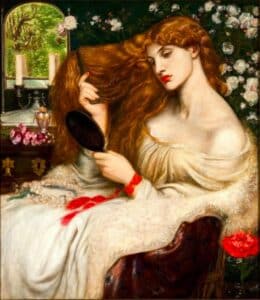 Her Dark Breath: Queer Currents within Nineteenth-Century Discourses on Lilith
Her Dark Breath: Queer Currents within Nineteenth-Century Discourses on Lilith Antique wind-spirit turned Adam’s first wife, Lilith is an enduring mythic figure who holds the fascination of academia and popular culture alike. Existing under numerous monikers and forms, and accompanying humanity from ancient Mesopotamia to the present day, more recent centuries have witnessed several reclamations, as well as weaponizations, of Lilith. Namely, nineteenth-century art, literature, and sociopolitical discourses are saturated with representations of this esoteric symbol of the feminine demonic. However, the scholarship on Lilith thus far positions her within a heteronormative framework. Additionally, the academic literature presents Lilith as a footnote of the modern Satanic milieu, rather than an influential cultural fixture in her own right. As a result, research on Lilith, her cultural reception, and discursive representations are underdeveloped, creating a blind spot in the study of esotericism, as well as cultural history at large.
In order to rectify these misconceptions, and provide a more complex and nuanced history of Lilith, this project will examine historical associations between the demoness Lilith and queerness within nineteenth-century artistic, literary, occult, and sociopolitical discourses. First, the ways in which Lilith was crafted as the penultimate perverse, deviant femme fatale, as a means to (quite literally) demonize queerness will be investigated. Additionally, by investigating how nineteenth-century queer actors – such as lesbian-pagan poetess Renée Vivien – utilized Lilith, reclamatory associations between Lilith and queerness are also exposed. By charting and analyzing an unexplored aspect of the history of one of the most enduring religious symbols of deviant femininity and sexuality, this project will demonstrate the interface between esotericism and queer studies, situating Lilith as a bridge between the two.
This research advances scholarship pertaining to Lilith’s reception history, as well as generates new ways of thinking about queer history – and how it relates to esotericism. As the nineteenth century witnessed a shift from understanding queerness as a sexual act to a (pathologized) identity, the psychological, medical, and socio-political discourses of the time are credited with demarcating and shaping said (re)conceptions of queerness that have carried into our current century. However, through examining nineteenth-century representations of Lilith, the ways in which esoteric discourses also engaged with and informed the development of nineteenth-century understandings of queerness will be uncovered. Ultimately, this project exposes not only historical associations between Lilith and queerness, but larger historical intersections between esotericism and queerness as well.
The Center for History of Hermetic Philosophy and Related Currents (HHP) is part of the Faculty of Humanities at the University of Amsterdam. We are committed to the highest standards of critical academic scholarship, independent of any worldview.
Visiting adress:
Bushuis / Oost-Indisch Huis
Kloveniersburgwal 48
1012 CX Amsterdam
The Netherlands
Postal adress:
Postbus 1622
1000BP Amsterdam
Email: hermetica-fgw@uva.nl
The Center for History of Hermetic Philosophy and Related Currents (HHP) is part of the Faculty of Humanities at the University of Amsterdam. We are committed to the highest standards of critical academic scholarship, independent of any worldview.
Visiting adress:
Bushuis / Oost-Indisch Huis
Kloveniersburgwal 48
1012 CX Amsterdam
The Netherlands
Postal adress:
Postbus 1622
1000BP Amsterdam
Email: hermetica-fgw@uva.nl
The Centre for History of Hermetic Philosophy and Related Currents (HHP) is part of the Faculty of Humanities at the University of Amsterdam. We are committed to the highest standards of critical academic scholarship, independent of any worldview.
Visiting adress:
Bushuis / Oost-Indisch Huis
Kloveniersburgwal 48
1012 CX Amsterdam
The Netherlands
Postal adress:
Postbus 1622
1000BP Amsterdam
Email: hermetica-fgw@uva.nl
© HHP 2022 – by Digital Marketing Agency MIAX